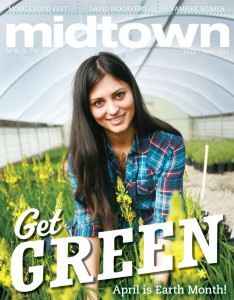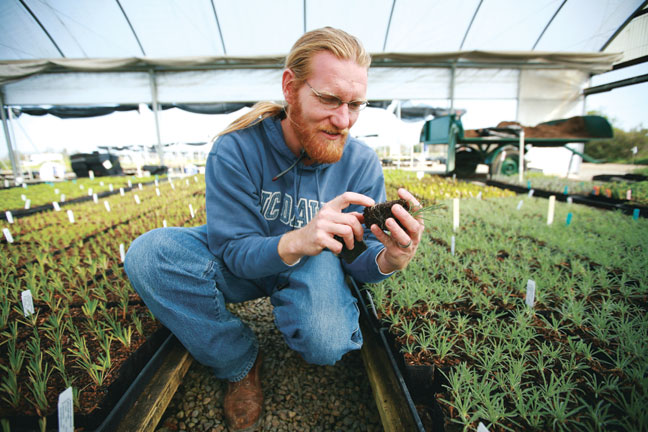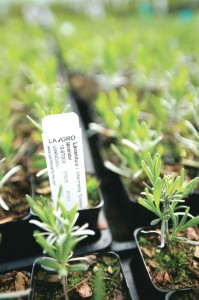Cornflower Farms
Posted on April 4, 2011 – 7:31 AM | by OldManFoster By Michele Hebert Photos by Scott Duncan
By Michele Hebert Photos by Scott Duncan
Have you ever wondered what Sacramento looked like before all the evergreen lawns, camellias, and Japanese maples were landscaped onto the scene?
Had you arrived here before the ‘49ers you’d have seen fields of purple needle grass, a tall tufted perennial with spiky purple-tinged flowers, and stands of valley oaks, deciduous trees with thickly ridged bark, deeply lobed leaves, and shiny brown acorns favored by local creatures. Hundreds of other plant species would have been here too, including the bush monkey-flower, a tall sub-shrub with long sticky leaves and tubular orange flowers attractive to hummingbirds and bees. You can still find examples of these plants in protected areas around the city, but rarely in the landscaping around houses or public buildings. How did we move so far from our natural state?
Early Sacramento residents mimicked the landscape design of the East coast where summertime rain keeps the lawns green without irrigation. The state’s management of water resources didn’t discourage that practice. Today you can detect signs of change just by taking a walk around town. The camellias in front of the Department of Food and Agriculture building on N Street were recently replaced by native plants like toyon, an evergreen shrub also known as California holly for its clusters of bright red berries, and a California rose bush, featuring fragrant white or pink flowers. Walking through the Old City Cemetery on Broadway one can’t help but notice the native plant demonstration garden put in by the Sacramento Chapter of the California Native Plant Society; frilly pink and white flower clusters of the California buckwheat mingle with about eighty other plants. A quick survey of the front yards in Midtown and other central neighborhoods show that an increasing number of people are ripping up their front lawn in favor of a native-cottagey look, often featuring the bright red tubular flowers of the California fuschia and the lacy white flowers of the feathery yarrow plant.
In the midst of this native plant renaissance, Sacramento has a high quality resource in its backyard. Elk Grove’s Cornflower Farms has been propagating native plants for nurseries and landscapers since 1981. The nursery is the kind of behind-the-scenes business that is unknown to the public but well-respected in the industry. Another reason for the nursery’s low-profile in its own hometown is that, although they sell to retail nurseries all over the state, including dozens in the Bay Area, they supply only one in the Sacramento region: Windmill Nursery in Carmichael.
 Taylor Lewis, the sales manager of Cornflower Farms, used to work at Windmill. “If you want your local nursery to carry native plants you have to ask them,” says Lewis, “It starts with the customer, they have all the power.” A handful of local landscapers consistently include native plants in their designs and buy from Cornflower; in particular Bernadette Balics with Ecological Landscape Design and Dave Roberts with Roberts Landscape. Neal Funston, Cornflower’s project manager, describes home gardeners as hesitant to commit to landscaping with natives, thinking it will drastically change the look of their yards. But by using natives, he says, “you can have every type of landscape, you just need to use less water.”
Taylor Lewis, the sales manager of Cornflower Farms, used to work at Windmill. “If you want your local nursery to carry native plants you have to ask them,” says Lewis, “It starts with the customer, they have all the power.” A handful of local landscapers consistently include native plants in their designs and buy from Cornflower; in particular Bernadette Balics with Ecological Landscape Design and Dave Roberts with Roberts Landscape. Neal Funston, Cornflower’s project manager, describes home gardeners as hesitant to commit to landscaping with natives, thinking it will drastically change the look of their yards. But by using natives, he says, “you can have every type of landscape, you just need to use less water.”
Cornflower sells plants that are native to all parts of California, but they have many that are specific to Sacramento. Funston and Lewis recommend planting trees like valley oaks, live oaks, box elders, and redbuds; and flowering plants like elderberry, California Dutchman’s pipevine, lupine, poppies, and monkey flowers. Plants native to the Sierra Nevada mountains like manzanita or penstemon also do well in the Sacramento Valley, and Cornflower sells these along with more than a dozen water-wise grasses, including a couple that you can use for a lawn: Red fescue and California field sedge.
 Until recently, central Sacramento households have been charged a flat rate for their water utility, so there has been no financial incentive to lower water usage. Since 2005 the City of Sacramento has been installing water meters as part of a state mandate to transition toward paying for the amount of water we actually use. This change may be the incentive Sacramentans need to start landscaping with climate-appropriate plants. Because we have a Mediterranean climate, many international drought-tolerant plants are suitable; but native plants provide the further benefit of creating habitat for native wildlife. As an example, local organic farms use native plants as hedgerows to offset the disruption to wildlife caused by agriculture, and provide shelter to beneficial insects.
Until recently, central Sacramento households have been charged a flat rate for their water utility, so there has been no financial incentive to lower water usage. Since 2005 the City of Sacramento has been installing water meters as part of a state mandate to transition toward paying for the amount of water we actually use. This change may be the incentive Sacramentans need to start landscaping with climate-appropriate plants. Because we have a Mediterranean climate, many international drought-tolerant plants are suitable; but native plants provide the further benefit of creating habitat for native wildlife. As an example, local organic farms use native plants as hedgerows to offset the disruption to wildlife caused by agriculture, and provide shelter to beneficial insects.
If you are hesitant to redo your yard entirely with natives, know that they can be mixed in with plants from other parts of the world, as long as the water needs are similar. In a sunny yard, the deciduous elderberry shrub with its clusters of tiny yellow-white flowers would provide a lovely backdrop for the drought-tolerant Mediterranean plants like rosemary and lavender that you probably already have there. Plenty of natives like shade: a wild currant or red twig dogwood (both deciduous and flowering) would be the perfect foil to a stand of bushy evergreen European euphorbia, which in turn would nicely set off some short and sweet little natives like wild ginger and fraises des bois.
Cornflower Farms does sell their plants directly to the public, but you must choose from a list on their website and email them your order, picking up your plants by appointment only. However, on April 9th and May 14th the nursery doors are open from 7:30 am to 2:00 pm so customers can shop from a selection of plants and take in a 10AM lecture about gardening with natives.
www.cornflowerfarms.com
Monday – Friday by appt. Only. Open 7am-2:30pm on April 9th and May 14th
9811 Sheldon Rd, Elk Grove



2 Responses to “Cornflower Farms”
By Matt Johnston on Oct 15, 2014 | Reply
Can I buy native plans from you or – – where can I buy them?